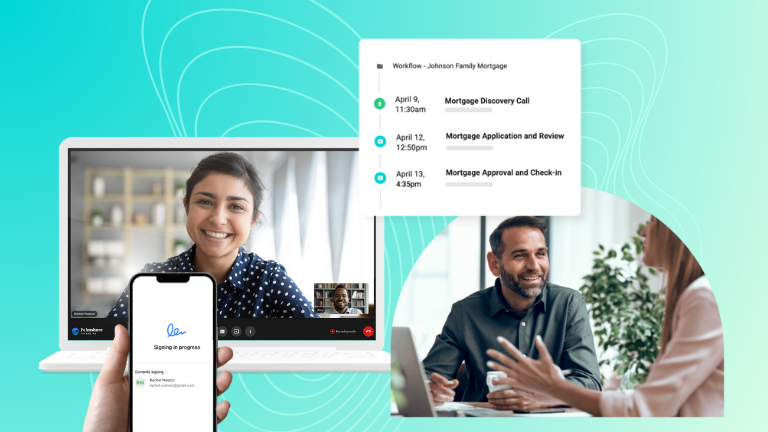The Importance of Securing Early Buy-In from Decision Makers

Securing Early Buy-In: Mirroring the customer service trends evident in retail and other industries, bank and credit union customers are seeking to interact with their financial service providers in new ways. In response, many FinServ organizations are beginning a front-end (and back-end) digital transformation.
Choosing the right technology solution for your organization is the first big hurdle, but planning and executing a successful implementation can be a challenge unto itself. One way to ensure that the implementation runs smoothly is by securing early buy-in from the decision-makers in your organization.
The Importance of Early Buy-In
Not acquiring early buy-in from your key decision-makers could leave you open to the risk of going through lengthy sales-cycles with various FinTech solutions, to ultimately find out that they do not meet the needs of the stakeholders in your organization. This ends up costing you time and slows down your digital transformation process.
Early buy-in from decision-makers will ensure you have support throughout the process, allowing for an efficient roll-out of your technology solution. It is in your best interests to start by assessing the needs of each stakeholder before you start the sales cycle for a new technology implementation. This way, the implementation process becomes much easier, increasing the pace at which your new implementation can be up and running with the support from ‘higher-ups’ within your organization.
Of course, bringing the solution to the attention of decision-makers early on in the process is one thing, but securing buy-in is another. Here are some ways your organization can gain support for your next technology investment.
Highlight the Operational Inefficiencies to Solve
The first step in securing buy-in from stakeholders is to bring operational inefficiencies to their attention. A significant part of any technology implementation is to correctly identify the issues affecting the operational process within your organization. By doing so, you will be able to choose an implementation that will effectively tackle what’s going wrong, and will also improve key processes.
Bringing these issues to the attention of decision-makers within your organization will help garner support for a new technology implementation. Issues that affect the customer experience and reduce efficiency mean the loss of revenue for your organization, and as soon as you highlight and emphasize issues that are currently affecting company revenue, decision-makers will be more likely to invest their support in a new solution.
Pitch a Solution, Not the Product
After highlighting the areas within your organization that are in need of an upgrade, it is wise to pitch the benefits of the new solution rather than the product itself.
As an example, let’s say that your organization is experiencing long contact handle times in its contact center, causing customers who are trying to book an appointment to drop off the line. And once appointments are booked, your customer-facing staff are seeing high no-show rates, in part because you have no way to send automated reminders or calendar invites for appointments. To solve these issues, you have decided to implement integrated appointment scheduling in your organization. Pitching the implementation as a product look like this –
“Integrated appointment scheduling will be beneficial to our organization, as it has many features that will enhance our operational processes, such as:
- The ability to track appointment analytics within our organization.
- Integration with our CRM and give customer-facing staff insight into customer history with our organization.
- Sending custom branded follow-up emails after appointment completion.
- Integration into our online platforms, giving customers 24/7, self-serve appointment scheduling.”
Yes, these are the benefits that come with integrated appointment scheduling, but they are not what you need to highlight to secure buy-in from stakeholders. Rather, we recommend cutting to the chase and instead, highlight how the solution will help you solving problems that you’re currently experiencing. Pitching the implementation as a solution to the organization’s operational issues looks like this –
“Integrated appointment scheduling is the right solution for our organization, as it has many features that will address the inefficiencies we are experiencing in our scheduling process. It will allow us to enhance the customer experience and improve operational processes, such as:
- Integrating all appointment scheduling applications into one platform.
- Streamlining the appointment scheduling process for our contact center representatives and significantly reducing contact handle time by having all applications on one platform.
- Automatically sending confirmation emails to customers after they have booked their appointment through the contact center.
- Using notifications to remind customers of their appointment to reduce the number of no-shows.”
Know the Solution & Paint the Picture
Highlighting the benefits of your ideal solution is beneficial, but drawing out how it will fit into your organization makes the idea more tangible, and increases your chances of buy-in. This is different from listing the features that will help solve the issues affecting your organization and is more of a “picture this” approach. Let’s say you have listed the benefits of an integrated appointment scheduling solution, but you still don’t have complete buy-in from your stakeholders. Now is the paint a picture of what the solution would look like in your organization –
Describe Your Current State
“Here is a breakdown of what currently happens in our contact center when a client tries to book an appointment:
- First Hold: Customer calls into the branch and is placed on hold for the next available representative.
- Basic details: Once the customer gets through to the representative, they are asked for their basic personal information, and what service they need.
- Second Hold: Customer is placed on hold for the second time while the contacts center representative searches through multiple platforms to find the necessary information to book the appointment.
- Checking branch locations: The representative searches for the nearest branch to the customer, typically using a geolocator.
- Searching available, qualified staff: Then the representative has to search through an extensive list of employees who work at that branch location to try and find an advisor who is qualified to conduct the service the customer requires.
- Checking staff availability: The contact center representative reviews the calendars of available and qualified advisors at the desired branch.
- (Finally) scheduling the appointment: The customer is taken off hold for the second time. Now, they can coordinate an appointment time that works for them and the qualified advisor.
- No further touchpoints: Once the appointment is booked, without any system for automating reminders, your customers won’t get a confirmation or reminder of their upcoming appointment.
This is a customer experience nightmare. And, it’s being caused by operation inefficacies within your organization that can be solved. Here is how implementing an integrated appointment scheduling platform can accelerate this process and reduce the length of each call. Instead of accessing multiple applications, the integrated platform streamlines the scheduling process and creates a better customer experience with our brand.
Illustrate How Your Solutions is a Game Changer
- Customer calls into the branch: Customer calls into the branch and connects to a contact center representative.
- Representative accesses the integrated scheduling platform: The representative is taken through a streamlined scheduling sequence.
- Quick navigation: Branch location, qualified branch staff, and advisor calendars are accessed in a matter of seconds.
- Scheduling the appointment: The contact center representative can easily schedule the appointment with the customer, having all qualified advisor calendars open on one platform.
- Additional touchpoints: Additional touchpoints are added to the scheduling process thanks to the integrated platform.
- Appointment confirmation: A confirmation email is automatically sent out to the customer with their appointment details.
- Reminder notifications: An automated SMS or email reminder is sent to the customer before the appointment date to decrease the chance of a no-show.”
By presenting the product in a clear and concise way, while highlighting where it fits into your organization, and the operational inefficiencies that it solves, you will be able to secure early buy-in from decision-makers. This ensures you have support from the higher-ups within your organization throughout the implementation process. And, it allows you to save time and frustration by going through a sales cycle knowing all of the requirements for the new solution beforehand, and avoiding the risk of objections down the line.
If you’re looking for more tips to help you pitch an integrated appointment scheduling solution internally, schedule a consultation today! You’ll find more information that will enable you to secure early buy-in from stakeholders in your organization.
What Next?
Looking to boost revenue and deliver a premium experience to your clients? Schedule a consultation with Coconut Software to learn more about how our appointment scheduling solutions can get you there.






